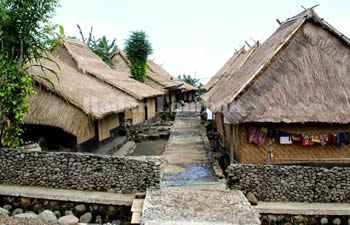West Nusa Tenggara Traditional Houses
Rumah Adat Dalam Loka is the residence of kings who came from Sumbawa Regency, West Nusa Tenggara. This house in Loka or Sumbawa palace is a historical legacy of the Sumbawa kingdom. Istana Dalam Loka was built in 1885 by Sultan Muhammad Jalalludin III (1983-1931). The traditional house in Loka is the original design of the residence of the kings of Sumbawa. The strong influence of Islamic culture that entered this area at that time had made almost all aspects of the adat and ethnicity of the Sumbawa people dissolve in Islamic sharia values.
The traditional house in Loka is in the form of a house on stilts with a building area of 904 M2. The Inner Palace looks very majestic. The palace, which was built with wood, has a philosophy of "adat stopping ko shara, syara barenti ko Kitabullah", which means that all the customs and values in the life of the tau Samawa (Sumbawa people) must be enthusiastic about Islamic law.
In Loka itself comes from 2 words in the Sumbawa language, namely "Dalam" which means "Palace" and "Loka" which means "World. The naming corresponds to the function of this traditional house which was used for the center of government and residence of the kings of Sumbawa in the past.
In accordance with this function, this Sumbawa traditional house has a fairly large design. The building which covers this area stands supported by 99 pillars which symbolize the 99 attributes of Allah (Asmaul Husna) in the teachings of Islam. The building in the loca faces south or to be precise towards the Sampar Hill and the town square. When entering this house there is a typical carving of the island of Sumbawa called Lutuengal. This typical carving of Sumbawa Island is usually a flower motif and also a leaf motif.
The traditional house in loka samawa only has one big access door for entry and exit. To enter, you can go through the front stairs that are owned by Dalam Loka, unlike other stairs. The ladder is in the form of a wooden floor that is tilted to touch the ground and the wooden floor is attached by pieces of wood to hold the step.
Generally, the main ingredients in Loka are all teak wood. The supporting poles are able to support the upright of the house which is divided into 2 equal sizes (twins) named Bala Rea or Graha Besar. In this Great Graha, there are several rooms that are separated by insulating walls according to their respective functions and names, namely:
Lunyuk Agung is located at the front of the building which functions as a meeting place, reception, or traditional and religious gatherings.
Lunyuk Mas, located next to Lunyuk Agung, functions as a special room for the empress, the wives of ministers, and important royal staff during traditional ceremonies.
The Inner Room which is located on the west. Some are only separated by a mosquito net and serve as a place for prayer, and to the north is the bedroom of the maids and empresses.
The Inner Room which is located on the east side consists of four rooms. These rooms are intended for married sons / daughters of the king.
The courtroom is located at the back of Bala Rea. Apart from being used for court meetings, at night this room is also used as a bed for the maids.
The bathroom is located outside the main room which extends from the king's bed room to the empress's room.
Bala Bulo is located beside Lunyuk Mas and consists of two floors. The first floor served as a playground for the kings who were still young, and the second floor served as a venue for watching performances on the palace grounds for the empress and the wives of the nobles.
Outside the Bala Rea building which is now known as Dalam Loka, as a unit of the entire Palace complex (Dalam). In ancient times there were still several important parts of the palace, namely the Keban Alas (palace garden), the Bala Buko (gate) of the palace walls, the Bale Jam (jam house), a special place where the royal bell was placed.
Since the construction of the new palace, in 1932 (the work palace which since 1954 has functioned as the official residence of the Regent of Sumbawa), the condition of Bala Rea as the main building of the palace complex in loka, is no longer suitable for occupancy and the descendants of work have begun to leave behind so that it was abandoned in such a way. So it is not surprising that when the Directorate General of Culture began to restore it in 1979, through the Sasana Budaya-Budaya Project from the 1979/1980 budget year to the 1984/1985 budget year, the conditions were so apprehensive — scrub covered the entire area of Bala rea.
Please feel free to contact us +62819 4492 9999  /whatsapp, if you need any information, We would be glad to giving you the assistance as you required.
/whatsapp, if you need any information, We would be glad to giving you the assistance as you required.




